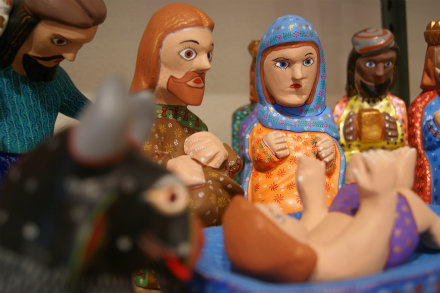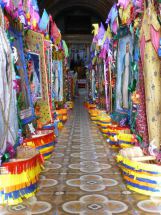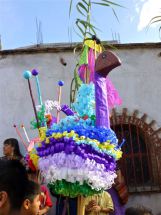Mexican Nativity Scenes
Posted: December 6, 2013 Filed under: Christmas, Mexican Folk Art, Mexican Holidays, Navidad, Religious Folk Art | Tags: Christmas, Mexican folk art, Nacimiento, Nativity Set, Navidad, Oaxaca, Wood Carvings Comments Off on Mexican Nativity ScenesDo you know someone who collects Nativities? Or someone who collects Nativities from all over the world? If you have someone on your list who loves Nativities, we’ve got you covered. Here are just a few of the many we have in our shop in Minneapolis, Minnesota. If you’d like to purchase one of these nacimientos, click on the photo to purchase through the Zinnia Folk Arts Online Shop.
Mexican Nativity Scenes or “Nacimientos” come in all sizes and in all media. The also come in various numerical configurations–five to twenty-five!
This is a very sweet and very tiny nacimiento made in Puebla, Mexico. There are 20 super tiny pieces (tallest is slightly over 1″) including the lovely Christmas cactus and lots of animals. The whole amazingly detailed set (and its “gold” tray) can be yours for $28.
This small nacimiento or nativity has 14 pieces and the tallest piece is about 2″ tall. It is made of clay and the little animals are all lying down. Jesus has his little hands waving in the air. Every piece is decorated in red. $42. Handmade in Mexico.
This is a charming nativity set carved and painted by the Santiago family in La Union, Oaxaca. The tallest piece (the angel) measures about 5.25″ tall. The carving is elegantly simple and the painting, bright and colorful. There are 10 pieces. Very unique and a lovely piece of Mexican folk art.
This is a stunning, large, wooden carved and painted 11 piece nativity set by Roberta Angeles, sister of Jacobo Angeles. They live in San Martin Tilcajete, Oaxaca. The pieces range in size from about 6″ to 9″. Each piece is painted in great detail. And the carving is exquisite. A beautiful set.
Do you have any questions? Or are you looking for another type of nacimiento? Send us an email with your questions!
Mexican Folk Art Christmas Tree Decorations
Posted: November 20, 2013 Filed under: Christmas, Folk Art, Mexican Crafts, Mexican Folk Art, Mexican Holidays, Navidad, Oaxaca, Tin | Tags: Celebrate the holidays, Christmas, handmade, Mexican crafts, Mexican folk art, Navidad, Tin, Wood Carvings Comments Off on Mexican Folk Art Christmas Tree DecorationsIt’s early, I know, but people are already buying Christmas tree ornaments in the Minneapolis shop! We have some very unique decorations and some of them are online. They are all handmade. That means they were not made by the millions by a machine. No, they were actually designed and made by hand, painted by hand and have all of the charm of bigger pieces of Mexican folk art but in a smaller size. And they come from different cities and artisans all over Mexico. Click on the photo to take you to the online shop!
 Wood carved animalitos from La Union, Oaxaca.
Wood carved animalitos from La Union, Oaxaca.
 Cute lacquered airplanes and pilots as a Mexican Christmas ornament handmade in Guerrero.
Cute lacquered airplanes and pilots as a Mexican Christmas ornament handmade in Guerrero.
 The star-shaped pinata shows up everywhere in Mexico during the Christmas season. These small straw pinatas decorated with yarn are pretty individually or linked together in a chain.
The star-shaped pinata shows up everywhere in Mexico during the Christmas season. These small straw pinatas decorated with yarn are pretty individually or linked together in a chain.
 Festive and colorful woven palm leaf Christmas ornaments. These come in a cluster of 12 and can be separated or left together.
Festive and colorful woven palm leaf Christmas ornaments. These come in a cluster of 12 and can be separated or left together.
 Beautiful tin musicians from Oaxaca, Mexico. These are 9″ tall and beautifully made. Unique.
Beautiful tin musicians from Oaxaca, Mexico. These are 9″ tall and beautifully made. Unique.
Have a question? Send us an email…
Build a Day of the Dead Ofrenda to Honor your Departed Loved Ones
Posted: September 27, 2013 Filed under: Day of the Dead, Mexican Folk Art, Mexican Holidays, Sugar Skulls, Zinnia Folk Arts Shop | Tags: Day of the Dead, Mexican folk art, Mexican holidays, papel picado, sugar skulls, Zinnia Folk Arts Minneapolis MN Comments Off on Build a Day of the Dead Ofrenda to Honor your Departed Loved OnesI wrote this last year but it’s still current! The only thing I want to add is:
1. We’re building a community ofrenda in the shop this year. Bring or email your photos of loved ones (or pets) to info@zinniafolkarts.com to be included in the ofrenda.
2. We’re offering some fun craft projects on Saturday, October 26, 2013 for adults and kids to decorate the ofrenda–make paper flowers & terracotta skulls that are similar to sugar skulls
3. I’m doing my “What is Day of the Dead” presentation on Friday, November 1 from 6-7:30 at the shop, 826 West 50th. Space is limited so you must register at info@zinniafolkarts.com.
Enjoy!
Are you unsure about how to build an ofrenda for the upcoming Days of the Dead? Here are a couple of examples from one of my trips to Mexico during Dia de los Muertos. Every ofrenda is unique and personal so don’t worry about whether you are doing it correctly or not. The main idea is to make an inviting altar that will entice the spirits of your departed loved ones to return to enjoy a few hours with you over November 1 and 2. Mexicans believe the smells of the flowers, food and copal incense are especially enticing. And the color of orange and magenta is traditional throughout Mexico. So here are a few ideas of what to include:
1. Marigolds: the color and smell of marigolds is believed to attract the spirits. But if you live in a northern climate, like I do, the marigolds are long…
View original post 380 more words
Let the festivities begin! | View From Casita Colibrí
Posted: July 11, 2013 Filed under: Folk Art, Mexican Crafts, Mexican Folk Art, Mexican Holidays, Mexico, Oaxaca, Paper Folk Art, Virgin of Guadalupe | Tags: handmade, Mexican crafts, Mexican folk art, Mexican holidays, Oaxaca, paper folk art, Virgin of Guadalupe 2 CommentsSunday in Tlacolula
Let the festivities begin!
July 11, 2013 by spixl
Monday, we returned to Teotitlán del Valle for the Fiesta titular a la Preciosa Sangre de Nuestro Señor Jesucristo — the pueblo’s most important festival of the year. While special masses have been celebrated at the Templo de la Preciosa Sangre de Cristo (the village church) since June 30, Monday’s convite (procession) by the unmarried women in the village, kicked off the more public events.
Lovingly decorated canastas (baskets) waited in the church to be reclaimed by their owners, placed on their heads, and carried through the streets.
Crowds gathered in the plaza in front of the church and sidewalks and streets along the route. And then it began — with solemn drum beats, fireworks, church bells, marmotas (cloth balloons on a pole), and a band.
Little boys (and a few girls) carrying model airplanes (don’t ask me why), paper mache lambs, and turkeys followed.
And then came the neatly organized rows of girls and young women.For over an hour they wound their way up and down and around the streets of Teotitlán del Valle. The weather was perfect, no late afternoon thunder showers this year, and it was glorious.
Stay tuned, the festivities continue all week. And, check out Oaxaca-The Year After this week for blogger buddy Chris’s photos and commentary.
via Let the festivities begin! | View From Casita Colibrí.
Custom Made Pinatas
Posted: December 17, 2012 Filed under: Folk Art, Mexican Crafts, Mexican Holidays, Mexican Style, Paper Mache, Pinatas, Unique gifts & Jewelry, Zinnia Folk Arts Shop | Tags: Celebrate the holidays, handmade, Mexican crafts, Mexican folk art, Mexican holidays, mexican style, paper folk art, paper mache, Pinatas Comments Off on Custom Made PinatasThis is the season for pinatas in Mexico. Big ones, small ones. The pinata maker in town will make lots of different ones to be purchased by families who will host the procession of visitors who go door to door looking for shelter–just like Mary and Joseph did so many thousands of years ago. The “Posadas” started yesterday, December 16th and will proceed every night until December 24th. The party at the last house will include the pinata game for children (and some adults). The pinatas traditionally have a clay pot in the center and then paper mache surrounding the pot and the star points. They come in lots of colors and sizes and designs and they are always a treat to see. Most public spaces will feature giant pinatas as decorations and they are especially gorgeous.
I have been embellishing pinatas since I started Zinnia Folk Arts several years ago and have several in the front of the store that I use for decoration. Over the years people have asked me to make them for their parties, bridal showers or weddings. This very pink pinata in the after photo is going to decorate a very sweet young girl’s room. I thought you’d be interested in seeing the before picture and the after. It used to be a Minnie Mouse pinata and now is a pink and green confection. Enjoy!
Here’s the before:
And here’s the after!
The Virgin of Guadalupe and Mexican Folk Art
Posted: December 12, 2012 Filed under: Mexican Crafts, Mexican Folk Art, Mexican Holidays, Mexican Style, Religious Folk Art, Unique gifts & Jewelry, Virgin of Guadalupe | Tags: basilica of guadalupe, handmade, Mexican crafts, Mexican folk art, Mexican holidays, mexican style, Religious folk art, Santos, Virgin of Guadalupe Comments Off on The Virgin of Guadalupe and Mexican Folk ArtIn Mexico, December 12 is the Fiesta of la Virgen de Guadalupe. Pilgrims from all over Mexico walk, ride buses, drive, ride bikes and even walk on their knees to arrive at the Basilica of Guadalupe that was built on the hill where Juan Diego saw the Virgin three times in the 1500’s. The tilma that was seen by Juan Diego is preserved in the Basilica and many, many people make pilgrimages to see it and to pray for help of all kinds. But it’s not just in Mexico City that people remember and celebrate her today–it’s everywhere in the country.
Guadalupe is a world-famous icon of the Virgin Mary. She is fondly known as the “Queen of Mexico.” Her image can be found everywhere in Mexico. She’s recognizable by the golden rays that surround her image and by the little cherub at her feet.
Here’s a photo of the original Basilica de Guadalupe in Mexico City.

Yes, it’s sinking! That’s partly why a new Basilica was built to the left of this photo. I like the old one better.
Light a candle and leave it outside one of several chapels on the Tepeyac Hill.
We carry 5″ tall Lux Candles. Take off the tissue paper and the lid, light it and wait for the image to be illuminated by the flame (it will take a while).
Folk artists use her image in every imaginable way and express their love and admiration for her through their media.
This is the Virgen de Guadalupe according to the Purepecha people of Michoacan. The whimsical Guadalupe wall plaque was made in Ocumicho.
Wooden bateas (carved trays) painted with the Virgin’s image come from Michoacan. These are decorative and are meant to be hung on the wall or set in a holder for display.
This is a reverse glass painting of la Virgen. The technique is an old-fashioned one but is being revived by a Mexico City artist, Manuel Bauman.
This is a large and lovely retablo with many saints on wood and painted in Michoacan. Available in the shop or by email!
This gorgeous tin cross decorated on the inside with Guadalupe and the symbolic roses comes from Oaxaca. Available in the shop or by email!
Nickel Silver earrings with the image of the Virgin available here.
And of course decorative boxes! These are especially lovely and very unique. They are from Mexico City. Available in the shop or by email.
Nativity Scenes from Mexico
Posted: December 4, 2012 Filed under: Christmas, Mexican Crafts, Mexican Folk Art, Mexican Holidays, Navidad, Religious Folk Art, Zinnia Folk Arts Shop | Tags: Celebrate the holidays, Christmas, handmade, Mexican art, Mexican Christmas, Mexican Christmas ornaments, Mexican crafts, Mexican folk art, Mexican holidays, mexican style, Navidad, Ornaments, Religious folk art 2 CommentsAs I’ve mentioned before, Mexico is predominantly a Catholic country (over 90%). So, much of the handmade folk art from every region is related to either the Virgin of Guadalupe, believing in miracles, wishing and hoping for protection from the bad, thanking God for the good, remembering the dead or expressing one’s faith. As we get closer to Christmas, the Christmas markets will start popping up allowing one to buy all kinds of decorations and food related to Christmas.
People buy complete nativity scenes in Mexico but there is also a tradition that happens in other parts of the world–buying the nativity scene one piece at a time. If you go to the Christmas markets you’ll see Baby Jesus in all kinds of sizes and colors as well as the lambs, cows, mangers and other nativity figures. You can purchase one or all or simply add on to your nativity scene every year. Jesus is also purchased separately because he doesn’t appear in the scene until December 24th…the Three Kings are added to the nativity on January 6th.
As always, if you have questions or would like to purchase any of these Mexican nacimientos, just let me know!
A Shiny and Glittery Mexican Folk Art Christmas
Posted: December 3, 2012 Filed under: Christmas, Folk Art, Mexican Crafts, Mexican Folk Art, Mexican Holidays, Mexican Style, Navidad, Religious Folk Art | Tags: Celebrate the holidays, Christmas, handmade, Mexican crafts, Mexican folk art, Mexican holidays, Navidad, Virgin of Guadalupe Comments Off on A Shiny and Glittery Mexican Folk Art ChristmasHere are a few examples of Mexican folk art in the shop for the Navidad season. There are lots of unique pieces–teeny little glittered Virgin of Guadelupe ($12) the beautiful large, Oaxacan, painted wall ornaments ($45), unpainted tin lumenaria in two sizes ($15 and $20), lovely tin pop-up nativity scenes inside a narrow box ($36), tiny little nacimiento boxes from Puebla ($18) and an amazing clay advent wreath from Izucar de Matamoros ($145).
None of these things are on the website but any of them can be purchased. Just let me know if you would like something. We ship all over the world!
Remembering the Dead Publicly during Dias de los Muertos
Posted: November 1, 2012 Filed under: Day of the Dead, Mexican Folk Art, Mexican Holidays, Mexican Style, Mexico | Tags: cockscomb, Day of the Dead, marigolds, Mexican folk art, Mexican holidays, mexican style Comments Off on Remembering the Dead Publicly during Dias de los Muertos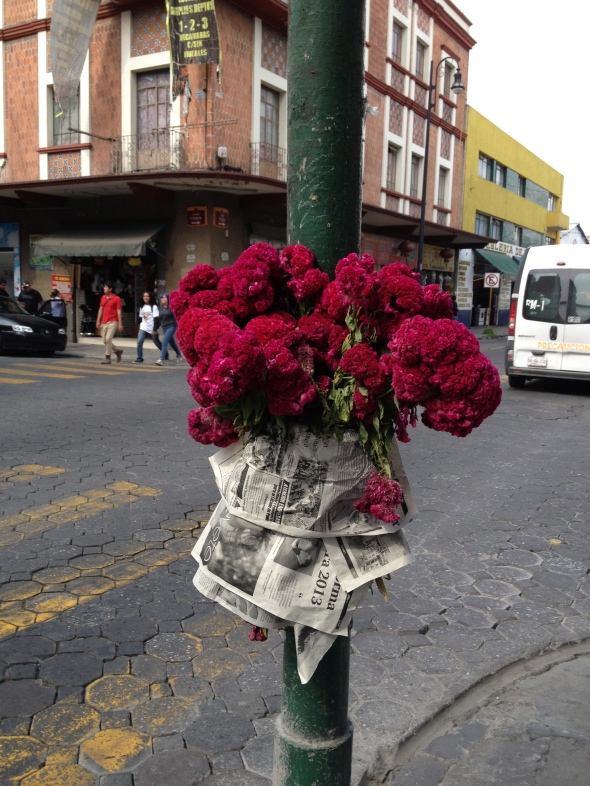
Public installations of folk art take many forms in Mexico. As I’ve said before, folk art is handmade, it is regional, it’s made of material available in one’s community, the methods are passed down from generation to generation and it expresses a community belief or value.
Here a simple bouquet of cockscomb attached to a traffic light in the middle of downtown Puebla not only provides passersby with a dab of beauty, but reminds everyone who passes, that a life was taken at this location. Someone died here. It raises our awareness that death is out there. In Mexico, death is not shoved into the back room. Death is a part of life and the Days of the Dead are a time to remember, both privately and publicly, those loved ones who have died.
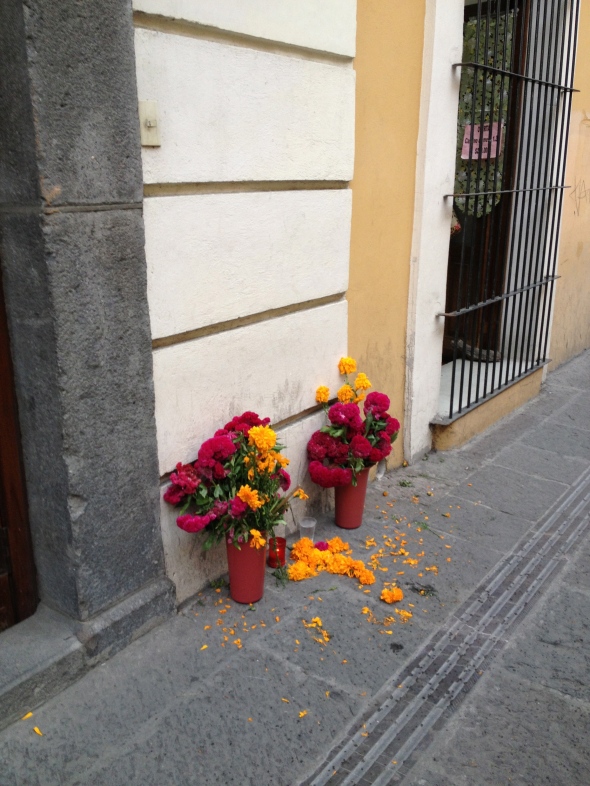
Someone else died here.
One sees bouquets and shrines built along the roads and highways of Mexico all year long. But during these special days of November 1 and 2, spontaneous eruptions of bouquets of marigolds and cockscomb appear in the cities and pueblos, reminding all of us that we are a mortal people and that life goes on after death.
Folk Art Surprises Every Day in Rural Mexico
Posted: July 28, 2012 Filed under: Folk Art, Mexican Holidays, Paper Folk Art | Tags: Mexican folk art, papel picado, paper folk art Comments Off on Folk Art Surprises Every Day in Rural MexicoOn Wednesday, while driving to Patzcuaro,my friend and I decided to take a side road to look for interesting new folk art. We happened on the Fiesta Patronal de Santiago in the tiny town of Cuanajo, Michoacan. Santiago is the Patron Saint of this little town. We parked the car just in time to see the parade of charros (cowboys) on their horses riding down the main street. We followed everyone to the sounds of the band, to the church grounds where the Padre was giving an outdoor mass right next to this beautiful overhead display of papel picado.



